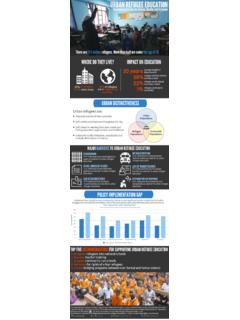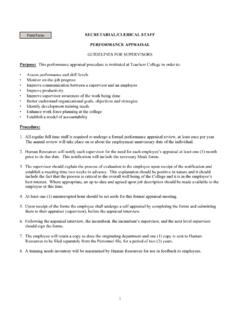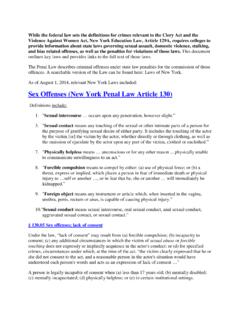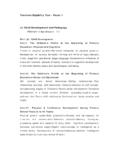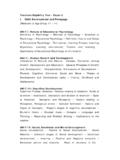Transcription of PEDAGOGY - tc.columbia.edu
1 TRAINING FOR PRIMARY SCHOOL TEACHERS IN CRISIS CONTEXTSPEDAGOGYMODULE 3 UNHCR/Benjamin LoyseauCore CompetenciesClassroom management: Teacher implements appropriate positive discipline strategies to manage student behavior. Teacher encourages participation of all children without discrimination regardless of gender, ethnicity, language, culture, religion or learning ability. Teacher ensures that the environment of the classroom promotes learning through the physical arrangement, and use of clear expectations, predictable procedures, and daily : Teacher uses varied age-appropriate techniques for instruction (lecture; pair, group, and whole-class work; read alouds, songs, games) including strategies suitable for large class size and multi-level or multi-grade student groups if relevant. Teacher asks various types and levels of questions to promote inquiry and critical thinking. Teacher has knowledge of child development and different learning styles. Teacher incorporates examples from local environment and student experience.
2 Assessment: Teacher uses a range of continuous and summative assessment tools to frequently check for understanding (quiz, test, drama, drawing, student discussions, projects, presentations, etc.). Teacher records and uses learning outcomes to monitor students progress towards meeting lesson/curricula objectives, and uses this to address the needs of his/her students and to inform his/her teaching 3 - PEDAGOGY Summary1 Session 1 Classroom ManagementSession 2 Active and Engaging LearningSession 3 QuestioningSession 4 child development and DifferentiationSession 5 AssessmentGrouping TechniqueFor this module, use the counting-off technique to group participants randomly. Give each participant a number, and ask all of the 1 s to work together, the 2 s to work together and so on. Groups should be made up of 4 people. For example, if you have 20 participants you will give each participant a number from 1 - 5. This is a useful technique in the classroom to encourage different students to work together and to promote inclusivity.
3 Focus TechniqueWhen you want to get the attention of the participants explain to them that you will use the shh strategy. When you would like them to be quiet and to focus on the facilitator, you will put your finger to your lips and say shh . All participants should copy your gesture and focus on the facilitator. Explain to participants that this is a calming strategy to use in the classroom, particularly with large class sizes and during group 3 - PEDAGOGY Summary2 Contextualization and Adaptation Guidance If possible, spend time in the participants classrooms and schools to see what types of PEDAGOGY are currently being used by the teachers and use this to inform the sessions. Session 1: Find out the relevant procedures for misbehavior in schools (minor and major) to share with participants. If participants have not completed Module 2 make time to include the corporal punishment activities in this session. Session 2: If participants are unfamiliar with learner-centered PEDAGOGY you may need to spend more time emphasizing the importance of active learning - there are example answers provided to help facilitators and participants.
4 Session 3: If possible locate a local folk story to use instead of the Acholi story. Session 5: If possible locate examples of national assessments to share with participants. Sessions 1-5: Review PowerPoint slides and contextualize as appropriate. Please note that if PowerPoint is not available, the PowerPoint slides for the session should be written on flipchart paper 3 - PEDAGOGY Summary3 This icon indicates the length of Time a particular Session should icon shows a Tip or Suggestion to help you along with the Session. This icon points to Questions you should ask your icon represents the Scripted section of the TO USE THIS MANUALI consModule 3 - PEDAGOGY How to Use this Manual4 SESSION 1 ClassroomManagement OBJECTIVESBy the end of this session, participants will be able to: Create a strong classroom community through effective classroom management strategies Implement classroom organization techniques and routines that promote student learning Use positive discipline to address misbehaviorOUTLINER eview competencies and expectationsMy favorite teacher My strengths and challengesProactive classroom managementReactive classroom managementClassroom management scenariosBrainstorming solutionsSkills and strategies worksheetIntroductionReflect and RevisitLearnPracticePlanning and ActionAssessModule 3 - PEDAGOGY Session 1 - Classroom Management 6 Prepare flipcharts for each activity, including key vocabulary flipchart (some need flipcharts even with a PowerPoint).
5 Prepare role-play cards using Appendix 3A. Work with local teachers and education officers to adapt and contextualize the session to reflect the classroom management challenges in the local context. Determine the behavior systems for both minor and major misbehaviors in the local Flipcharts, markers, extra paper, colored markers Handout - Identifying and Addressing Classroom Concerns Handout - Big Five - Classroom Management Strategies Handout - Preventing Misbehavior Handout - Positive Discipline Appendix 3A - Classroom Management Role-play Textbook prop for role-playPRE-WORK FOR FACILITATORSM odule 3 - PEDAGOGY Session 1 - Classroom Management 7 Key Words Classroom Management: Classroom management refers to the wide variety of skills and techniques that teachers use to keep students organized, orderly, focused, attentive, on task, and academically productive during a class. Essentially, everything that teachers may do to facilitate or improve student learning, which would include such factors as behavior, environment, materials, or activities, is a part of their classroom management.
6 Corporal Punishment: Any punishment in which physical force is used and intended to cause some degree of pain or discomfort, however light. In addition, there are other non-physical forms of punishment which are also cruel and degrading and thus incompatible with the Convention on the Rights of the child . These include, for example, punishment which belittles, humiliates, denigrates, scapegoats, threatens, scares or ridicules the child . PEDAGOGY : PEDAGOGY refers to the strategies or styles of instruction and learning processes; the study of being a teacher. PEDAGOGY is the observable act of teaching and modeling values and attitudes that embodies educational theories, values, evidence, and justifications. Proactive Classroom Management: Practices to create an effective learning environment in your classroom, such as developing relationships, building a community, motivating students and making routines. Reactive Classroom Management: How you respond to unwanted student behavior, often referred to as discipline.
7 Module 3 - PEDAGOGY Session 1 - Classroom Management 8 Materials: Slides 1-2 Welcome to the third part of our teacher professional development training. This training was developed with the understanding that you as teachers are also learners, who must be supported to develop, determine, and assess your own learning. It is based on the principle that collaboration among teachers will strengthen your practice and help support you as individuals, professionals, members of their communities and as people coping with the effects of crisis. This training was designed to give ample time and freedom for you to develop your own ideas and methods to create on-going, sustainable professional development . This training is designed around five core competencies for primary education teachers in crisis contexts. The training is divided into four modules, covering teacher s role and well-being; child protection, well-being and inclusion; PEDAGOGY ; and curriculum and planning. Within each module there are several training sessions to draw on your existing knowledge and experience and to give you concrete skills and strategies for you to take back to your classroom.
8 It will also include time to practice and reflect on those skills throughout the training. Today we are going to explore PEDAGOGY . This includes effective classroom management, instruction that is active and engaging, promoting critical thinking, questioning techniques, differentiation and varied we start today s session I would like us to discuss our expectations of each other. Let s make a list on the board/flipchart paper of what we expect of each other throughout our time together. This can be paraphrased based on how recently the last training was held. This would also be a good time to share an overview of the agenda for the training and a reminder of when and where all the trainings and modules will be taking place. INTRODUCTIONR eview Competencies and ExpectationsModule 3 - PEDAGOGY Session 1 - Classroom Management 9 Now that we all understand the purpose of this training, our expectations of each other throughout the training and we know a little bit more about who we are learning with, let s get started!
9 Insert an opportunity for participants to introduce themselves formally or through an energizer/ice-breaker the grouping technique and the focus technique that will be used throughout the Answers: Be on time. No cell phones. Respect each other. Give everyone opportunity to respond. Raise your hand. Be open to new ideas. Don t be afraid to ask questions. Provide participants have already completed this exercise in training together in Module 1, use this time to review the expectations already set as a group and see if participants would like to make any additions or 3 - PEDAGOGY Session 1 - Classroom Management 10 Materials: Slides 3-4 To start today s session I would like you to reflect on past teachers in your life and think about the type of teacher you would like to be. This is called a visioning activity . Draw the chart on the PowerPoint/flipchart in your notebook. The chart has 4 columns: teacher actions, student actions, classroom environment and feeling.
10 Classroom environment refers to the physical structure of the classroom and any visual aids or decorations that are posted. Use feeling to describe how it would feel to be in that classroom. I am going to ask you three questions. You will have 5 minutes to answer each question in the chart. After each question we will discuss your answers as a whole group. Fill in the first row on the chart. Under teacher actions I could write, asks interesting questions or supports students . Under student actions I could write, playing a game . Under classroom environment I could write, Pictures on the wall . Under feeling I could write, excited, comfortable . After 5 minutes discuss answers as a whole group. Write answers on flipchart/board. REFLECT AND REVISITMy Favorite TeacherAsk Participants (Individual Reflection followed by whole group discussion):Think back on teachers in your was your favorite teacher? What was it like to be a student in their classroom?Ask Participants (Individual Reflection followed by whole group discussion):Think back on teachers in your was your least favorite teacher?


